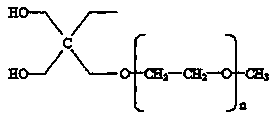Preparation method of non-ionic waterborne polyurethane-polyacrylate composite emulsion for leather finishing
A technology of polyacrylate and water-based polyurethane, which is applied in polyurea/polyurethane coatings, leather surface treatment, small raw hide/large raw hide/leather/fur treatment, etc. It can solve the problems of poor compound stability and achieve low viscosity and good Embossed shape and texture, and the effect of improving freeze-thaw resistance
- Summary
- Abstract
- Description
- Claims
- Application Information
AI Technical Summary
Problems solved by technology
Method used
Image
Examples
Embodiment 1
[0053] The number average molecular weight after vacuum dehydration is 10.0g of polyoxypropylene glycol of 2000, hydroxyl value 56mgKOH / g, 4.0g of isophorone diisocyanate, 9.2g of trimethylolpropane polyethylene glycol monomethyl ether , Add 0.024g of catalyst dibutyltin dilaurate into a 250mL reaction vessel, control the temperature under mechanical stirring and react at 85°C for 3 hours, take a sample to measure the NCO content, when the NCO content reaches the predetermined value (0.0076mol) or below, put The temperature of the system is lowered to room temperature, add 3.60g of butyl acrylate, 4.00g of methyl methacrylate, and 4g of acetone, continue to stir for 15-30 minutes, add 26g of deionized water under high shear force at 950rpm, emulsify for 2min, and then add 70g Deionized water, continue to emulsify for 13 minutes, reduce the stirring speed, dropwise add a hydrazine hydrate solution composed of 0.24g hydrazine hydrate (mass fraction 80%) and 4g water, react for 1 ...
Embodiment 2
[0069] After vacuum dehydration, 16.8g of polycarbonate diol PCD with a number average molecular weight of 2000 and a hydroxyl value of 53-59mgKOH / g, 8.0g of isophorone diisocyanate, trimethylolpropane polyethylene glycol monomethyl Add 11.6g of ether and 0.08g of catalyst dibutyltin dilaurate into a 250mL reaction vessel, control the temperature under mechanical stirring and react at 85°C for 3 hours, then take a sample to measure the NCO content, when the NCO content reaches the predetermined value (0.0321mol) or below When the temperature of the system was lowered to room temperature, 6.6 g of butyl acrylate, 5.0 g of methyl methacrylate, and 6 g of acetone were added, and the stirring was continued for 15 to 30 minutes. Then, 26 g of deionized water was added under high shear force at 950 rpm, and emulsified for 2 min. Then add 70g of deionized water, continue to emulsify for 13 minutes, reduce the stirring speed, dropwise add a hydrazine hydrate solution consisting of 1.00...
Embodiment 3
[0071] After vacuum dehydration, 8.62g of polyoxypropylene glycol with a number average molecular weight of 1000 and a hydroxyl value of 112mgKOH / g, 6.75g of isophorone diisocyanate, and 9.59g of trimethylolpropane polyethylene glycol monomethyl ether , Add 0.025g of catalyst dibutyltin dilaurate into a 250mL reaction vessel, control the temperature under mechanical stirring and react at 85°C for 3 hours, take a sample to measure the NCO content, when the NCO content reaches the predetermined value (0.0244mol) or below, put The temperature of the system is lowered to room temperature, add 5.24g of butyl acrylate, 1.13g of methyl methacrylate, 4g of acetone, continue to stir for 15-30 minutes, add 27g of deionized water under high shear force at 950rpm, emulsify for 2min, then add 53g Deionized water, continue to emulsify for 13 minutes, reduce the stirring speed, dropwise add a hydrazine hydrate solution composed of 0.76g hydrazine hydrate (mass fraction 80%) and 4g water, reac...
PUM
| Property | Measurement | Unit |
|---|---|---|
| hydroxyl value | aaaaa | aaaaa |
| hydroxyl value | aaaaa | aaaaa |
| hydroxyl value | aaaaa | aaaaa |
Abstract
Description
Claims
Application Information
 Login to View More
Login to View More - R&D
- Intellectual Property
- Life Sciences
- Materials
- Tech Scout
- Unparalleled Data Quality
- Higher Quality Content
- 60% Fewer Hallucinations
Browse by: Latest US Patents, China's latest patents, Technical Efficacy Thesaurus, Application Domain, Technology Topic, Popular Technical Reports.
© 2025 PatSnap. All rights reserved.Legal|Privacy policy|Modern Slavery Act Transparency Statement|Sitemap|About US| Contact US: help@patsnap.com


